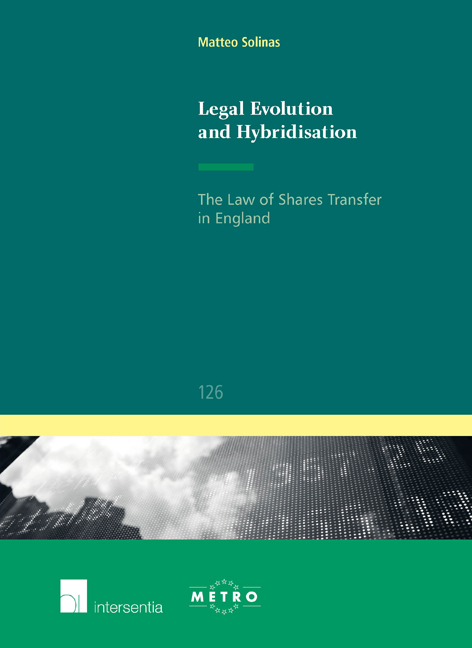Book contents
- Frontmatter
- Foreword
- Preface
- Acknowledgements
- Contents
- Table of Cases
- Introduction
- PART I THE IDEA OF HYBRIDITY IN COMPARATIVE LAW
- PART II THE CIRCULATION OF SHARES
- PART III THE TRANSFER OF (INTERESTS IN) SHARES
- Introduction to Part III
- Chapter 6 Indirect Holding and the Process of Legal Evolution
- Chapter 7 The Protection of the Innocent Transferee of Intermediated Shares
- Summary of Part III
- Conclusions
- Bibliography
- IUS COMMUNE EUROPAEUM
Chapter 6 - Indirect Holding and the Process of Legal Evolution
from PART III - THE TRANSFER OF (INTERESTS IN) SHARES
Published online by Cambridge University Press: 22 November 2017
- Frontmatter
- Foreword
- Preface
- Acknowledgements
- Contents
- Table of Cases
- Introduction
- PART I THE IDEA OF HYBRIDITY IN COMPARATIVE LAW
- PART II THE CIRCULATION OF SHARES
- PART III THE TRANSFER OF (INTERESTS IN) SHARES
- Introduction to Part III
- Chapter 6 Indirect Holding and the Process of Legal Evolution
- Chapter 7 The Protection of the Innocent Transferee of Intermediated Shares
- Summary of Part III
- Conclusions
- Bibliography
- IUS COMMUNE EUROPAEUM
Summary
This chapter looks at the process of legal change in the area of post-trading following the growth of intermediation in financial markets.
Section 1 analyses the meaning of the move from direct to indirect (book-entry) holdings, from the pattern of holding shares to the one of holding interests/entitlements in shares. It then discusses some of the most significant sources of legal risk arising from the evolution of financial practice by placing special emphasis on certain deficiencies and ambiguities in English law and argues for law reform. Given the interconnection between financial markets, it finds that it makes little sense to promote legal change merely at a national level and proposes that coordinated international action to address legal uncertainties is preferable.
Building on this, section 2 assesses the responses to legal uncertainty provided by two of the most important existing normative projects on the transfer of indirectly held securities: the Geneva Securities Convention and the EU Commission project on clearing and settlement. It is, in particular, by looking closely at the preparatory works and at certain issues of the final text of the Geneva Securities Convention that the pattern of growth of English law is examined and the process of hybridisation revealed.
Underlying Themes
At the heart of the law reform debate on post-trading is the ubiquitous commercial practice of intermediation, the fact that investors do not physically hold investment securities any more. Today in capital markets it is customary for securities1 to be held and circulated through fi nancial intermediaries and to employ local sub-custodians in cross-border transactions. Investors purchase and sell, and provide collateral to secured lenders on their holdings by means of book-entries made in the securities account kept with the intermediary. Intermediated securities are intangibles evidenced in electronic records of the intermediary, usually on an unallocated basis, commingled with those of other investors. This holding pattern is operationally convenient as it reduces administration and allows transfers of securities from one customer to another to be effected through the books of the intermediary. It also allows for the smooth performance of complex brokerage and investment management services even when dealing with large securities portfolios.
- Type
- Chapter
- Information
- Legal Evolution and Hybridisation , pp. 141 - 174Publisher: IntersentiaPrint publication year: 2014



